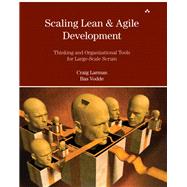
What is included with this book?
Craig Larman is a management and product development consultant in enterprise-level adoption and use of lean development, agile principles and practices, and large-scale Scrum in large, multisite, and offshore development. He is chief scientist at Valtech, an international consulting and offshore outsourcing company. His books include the best-sellers Agile & Iterative Development: A Manager’s Guide (Addison-Wesley, 2004) and Applying UML and Patterns, Third Edition (Prentice Hall, 2005).
Bas Vodde works as an independent product-development consultant and large-scale Scrum coach. For several years he led the agile and Scrum enterprise-wide adoption initiative at Nokia Networks. He is passionate about improving product development, an avid student of organizational, team management, and product development research, and remains an active developer.
| Preface | |
| Introduction | p. 1 |
| Thinking Tools | |
| Systems Thinking | p. 9 |
| Lean Thinking | p. 39 |
| Queueing Theory | p. 93 |
| False Dichotomies | p. 125 |
| BeAgile | p. 139 |
| Organizational Tools | |
| Feature Teams | p. 149 |
| Teams | p. 193 |
| Requirement Areas | p. 217 |
| Organization | p. 229 |
| Large-Scale Scrum | p. 289 |
| Miscellany | |
| Scrum Primer | p. 305 |
| Recommended Readings | p. 327 |
| Bibliography | p. 333 |
| Index | p. 343 |
| Table of Contents provided by Publisher. All Rights Reserved. |
The New copy of this book will include any supplemental materials advertised. Please check the title of the book to determine if it should include any access cards, study guides, lab manuals, CDs, etc.
The Used, Rental and eBook copies of this book are not guaranteed to include any supplemental materials. Typically, only the book itself is included. This is true even if the title states it includes any access cards, study guides, lab manuals, CDs, etc.